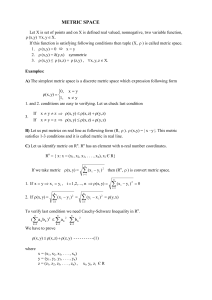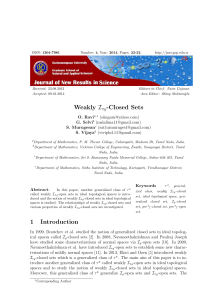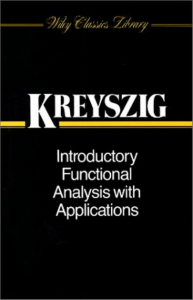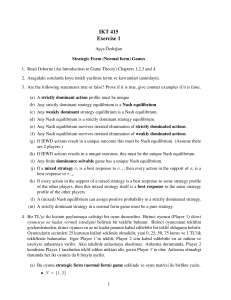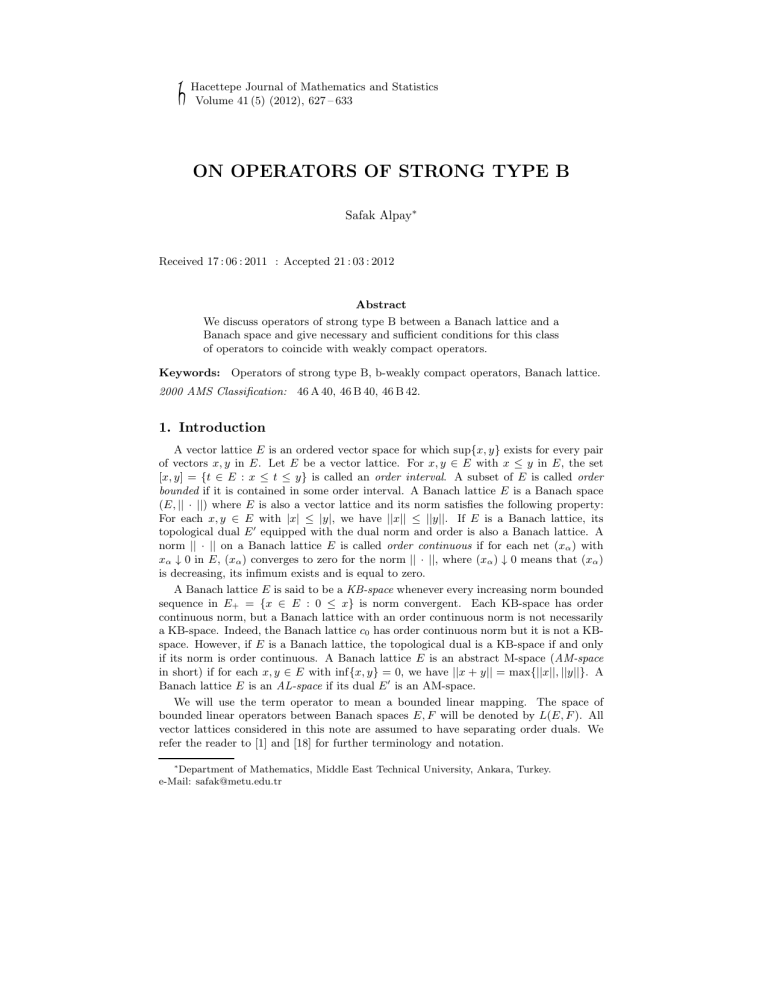
Hacettepe Journal of Mathematics and Statistics
Volume 41 (5) (2012), 627 – 633
ON OPERATORS OF STRONG TYPE B
Safak Alpay∗
Received 17 : 06 : 2011 : Accepted 21 : 03 : 2012
Abstract
We discuss operators of strong type B between a Banach lattice and a
Banach space and give necessary and sufficient conditions for this class
of operators to coincide with weakly compact operators.
Keywords: Operators of strong type B, b-weakly compact operators, Banach lattice.
2000 AMS Classification: 46 A 40, 46 B 40, 46 B 42.
1. Introduction
A vector lattice E is an ordered vector space for which sup{x, y} exists for every pair
of vectors x, y in E. Let E be a vector lattice. For x, y ∈ E with x ≤ y in E, the set
[x, y] = {t ∈ E : x ≤ t ≤ y} is called an order interval. A subset of E is called order
bounded if it is contained in some order interval. A Banach lattice E is a Banach space
(E, || · ||) where E is also a vector lattice and its norm satisfies the following property:
For each x, y ∈ E with |x| ≤ |y|, we have ||x|| ≤ ||y||. If E is a Banach lattice, its
topological dual E ′ equipped with the dual norm and order is also a Banach lattice. A
norm || · || on a Banach lattice E is called order continuous if for each net (xα ) with
xα ↓ 0 in E, (xα ) converges to zero for the norm || · ||, where (xα ) ↓ 0 means that (xα )
is decreasing, its infimum exists and is equal to zero.
A Banach lattice E is said to be a KB-space whenever every increasing norm bounded
sequence in E+ = {x ∈ E : 0 ≤ x} is norm convergent. Each KB-space has order
continuous norm, but a Banach lattice with an order continuous norm is not necessarily
a KB-space. Indeed, the Banach lattice c0 has order continuous norm but it is not a KBspace. However, if E is a Banach lattice, the topological dual is a KB-space if and only
if its norm is order continuous. A Banach lattice E is an abstract M-space (AM-space
in short) if for each x, y ∈ E with inf{x, y} = 0, we have ||x + y|| = max{||x||, ||y||}. A
Banach lattice E is an AL-space if its dual E ′ is an AM-space.
We will use the term operator to mean a bounded linear mapping. The space of
bounded linear operators between Banach spaces E, F will be denoted by L(E, F ). All
vector lattices considered in this note are assumed to have separating order duals. We
refer the reader to [1] and [18] for further terminology and notation.
∗
Department of Mathematics, Middle East Technical University, Ankara, Turkey.
e-Mail: [email protected]
628
S. Alpay
2. Operators of strong type B
A subset B of a vector lattice E is called b-order bounded in E if it is order bounded
in the order bidual E ∼∼ . Clearly every order bounded subset of E is b-order bounded.
However, the converse does not hold in general. Indeed, the subset B = {en }, where (en )
is the sequence of reals with all terms are zero except the n’th which is one, is a b-order
bounded sequence in c0 which is not order bounded in c0 . A vector lattice E is said to
have the b-property if each b-order bounded subset of E is order bounded in E. The
b-property and vector lattices with the b-property were defined and studied in [2,3,6,7],
and [8].
Let E be a Banach lattice and X a Banach space. An operator T : E → X is called a
b-weakly compact operator if T maps b-order bounded subsets of E into relatively weakly
compact subsets of X. b-weakly compact operators are studied in the papers [4,5,7,8] and
[10-15]. b-weakly compact operators also appear in the papers [16-17], and [18] under the
name operators of type B. The space of b-weakly compact operators between a Banach
lattice E and a Banach space X will be denoted by Wb (E, X). Let us recall that an
operator T : E → X is called order weakly compact if T (B) is relatively weakly compact
in X for each order bounded subset B of E. We refer the reader to [1] for an account of
order weakly compact operators. The space of order weakly compact operators between
a Banach lattice E and a Banach space X will be denoted by Wo (E, X). If W (E, X)
is the space of weakly compact operators between E and X, then we have the following
inclusions:
W (E, X) ⊆ Wb (E, X) ⊆ Wo (E, X)
between the classes of operators introduced above. Let us note that these inclusions may
well be proper [5,17].
The following class of operators was introduced in [19].
2.1. Definition. An operator : E → X from a Banach lattice E into a Banach space
X is called an operator of strong type B if T ′′ , the second adjoint of T , maps the band
B(E), generated by E in E ′′ , into X.
The space of operators of strong type B will be denoted by Wsb (E, X). Since E ′′ is
Dedekind complete, every band in E ′′ is a projection band and in particular, there is a
positive projection from E ′′ onto B(E). Thus, operators of strong type B extend to E ′′ .
One of the open problems put forward in [19] was the existence of a b-weakly compact
operator which is not of strong type B. This question was settled in [16] and it was shown
that there does exist a b-weakly compact operator which is not of strong type B. Thus
we have:
W (E, X) ⊆ Wsb (E, X) ⊆ Wb (E, X) ⊆ Wo (E, X),
where the inclusions may be proper. Let us remark that operators of strong type B are
of substance only when they do not coincide with weakly compact or b-weakly compact
operators. For example, when E has order continuous norm or is an AM-space then we
have Wsb (E, X) = Wb (E, X). On the other hand, when E is a KB-space, then E = B(E)
and each operator T : E → X is an operator of strong type B and we have:
Wsb (E, X) = Wb (E, X) = Wo (E, X) = L(E, X).
Similarly, when E ′ has order continuous norm (i.e. l1 does not embed in E) and c0 does
not embed in X, then the Grothendieck-Ghoussoub-Johnson Theorem (cf. [1, Theorem
17.6]) asserts that each operator T : E → X is weakly compact and again we have
W (E, X) = Wsb (E, X) = Wb (E, X) = Wo (E, X) = L(E, X). The space of operators of
On Operators of Strong Type B
629
strong type B is a norm closed subspace of L(E, X) and is an order ideal whenever F is
a Banach lattice.
Let E, F be Banach lattices and T : E → F a positive operator. Let x ∈ B(E) be
an arbitrary positive vector. Then there exists a net {xα } of positive elements in the
order ideal I(E) generated by E in E ′′ such that xα ↑ x in E ′′ , i.e. x = supα xα (cf. [1,
Theorem 3.4]). Since adjoint operators are order continuous (cf. [1, Theorem 5.8]), we
have T ′′ xα ↑ T ′′ x in F ′′ . As T is a positive operator, T ′′ maps the order ideal generated
by E in E ′′ into the order ideal generated by F in F ′′ . It follows that T ′′ x ∈ B(F ). In
particular, if F is a KB-space, it follows that each positive and therefore each regular
(difference of two positive operators) operator is of strong type B. It also follows from this
observation that if an operator T : E → X factors over a KB-space as R ◦ S where the
first factor S is order bounded, then T is of strong type B. As a result of this observation
and [1, Theorem 14.15], we see that if T : E → X is an operator from a Banach lattice E
into a Banach space X which does not contain a copy of c0 , then T admits a factorization
through a KB-space F as T = S ◦ Q where Q is a lattice homomorphism. Since a lattice
homomorphism is a positive operator, it follows that T is of strong type B.
Utilizing [18, Theorem 3.5.8], we see that if T : E → X is an operator for which T ′′ is
order weakly compact, then T factors over a KB-space F as T = S ◦ Q, where Q : E → F
is an interval preserving lattice homomorphism and S ∈ L(F, X). Therefore if T ′′ is
order weakly compact, then T is of strong type B.
Finally, let E, F be Banach lattices and X a Banach space. Let T : E → F, S : F → X
be two operators. If F has order continuous norm and S is b-weakly compact, then S
factors over a KB-space [8]. Consequently, the operator S ◦ T is of strong type B.
We close this section with an intrinsic characterization of operators of strong type
B. Let E be a Banach lattice and I(E) the closed order ideal in E ′′ generated by E.
According to the main Theorem in [17], T is of strong type B if and only if the restriction
of T ′′ to I(E) does not preserve c0 . This enables us to give the following:
2.2. Proposition. The operator T : E → X is of strong type B if and only if (T ′′ xn ) is
convergent for each increasing sequence (xn ) in I(E) with ||xn || ≤ 1 for all n.
Proof. =⇒ If T is of strong type B, then T ′′ |I(E) does not preserve a copy of c0 . Hence,
by [18, Theorem 3.4.11], (T xn ) is convergent for each increasing sequence in BI(E) , where
BI(E) is the closed unit ball of I(E).
⇐= If T ′′ (xn ) is convergent for each increasing sequence in BI(E) , then T ′′ |I(E) does
not preserve a subspace isomorphic to c0 and consequently T is of strong type B.
3. When is Wsb (E, X) = W (E, X) ?
The following result was claimed for b-weakly compact operators in [11]. In one part
of the proof the authors were misguided by an erroneous part of [5, Proposition 2].
However, their claim is still true for operators of strong type B. We now state and prove
this result. The proof follows the same lines as in [11]. In order to identify when we have
W (E, X) = Wsb (E, X), we need a lemma which is a combination of theorems 116.1 and
116.3 in [20].
3.1. Lemma. Suppose E ′ does not have order continuous norm. Then there exist a
disjoint sequence (un ) of positive elements in E with ||un || ≤ 1 for all n, 0 ≤ φ ∈ E ′ and
ǫ > 0 satisfying φ(un ) > ǫ for all n. Moreover, the components φn of φ in the carriers
′
Cun form an order bounded disjoint sequence in E+
such that φn (un ) = φ(un ) for all n
and φn (um ) = 0 if n 6= m.
630
S. Alpay
3.2. Proposition. Let E be a Banach lattice and X a Banach space. The following are
equivalent:
1) W (E, X) = Wsb (E, X).
2) One of the following hold:
a) E ′ has order continuous norm,
b) X is reflexive.
Proof. 2a =⇒ 1 Let T be an operator of strong type B and let B(E) be the band generated
by E in E ′′ . Then T ′′ B(E) ⊆ X. Since E ′ has order continuous norm E ′′ = B(E) and
T ′′ (E ′′ ) ⊆ X. Thus T is weakly compact.
2b =⇒ 1 In this case each operator T : E → X is weakly compact.
1 =⇒ 2 Suppose E ′ is not a KB-space and X is not reflexive. Then we construct an
operator of strong type B which is not weakly compact. Since E ′ is not a KB-space, it
follows from the preceding lemma that there exist a disjoint sequence (un ) in E+ with
′
||un || ≤ 1 for all n and some φ ∈ E+
, ǫ > 0 such that φ(un ) > ǫ for all n. The components
′
φn of φ in the carriers Cun of un form an order bounded disjoint sequence in E+
such
that φ(un ) = φn (un ) and φm (un ) = 0 if n 6= m. Note that we have 0 ≤ φn ≤ φ for all n.
Let us define T1 : E → l1 by
φn (x)
T1 (x) =
φ(un )
for each x ∈ E. Since
∞ ∞
X
φn (x) 1X
1
φn (|x|) ≤ φ(|x|)
φ(un ) ≤ ǫ
ǫ
n=1
n=1
the operator T1 is well-defined, positive and as l1 is a KB-space, it is of strong type B.
On the other hand, since X is not reflexive, the closed unit ball BX of X is not weakly
compact. Hence we can find a sequence (yn ) in BX without any weakly convergent
subsequences. Let us define the operator T2 : l1 → X by T2 (αn ) = Σαn yn . Since
Σ||αn yn || ≤ Σ|αn |, T2 is well-defined. We consider the operator T = T2 ◦T1 : E → l1 → X
defined by
X φn (x)
T (x) =
yn
φ(un )
n
for each x ∈ E. As T factors over the KB-space l1 , and the first factor T1 is positive,
T is of strong type B. However as T (un ) = yn and since (yn ) is chosen not to have any
weakly convergent subsequences, T is not weakly compact.
The preceding theorem cannot be extended to b-weakly compact operators. There is
a Banach lattice E with E ′ a KB-space and a non-weakly compact operator T : E → c0
which is b-weakly compact [4].
We now give some consequences of the preceding result.
3.3. Corollary. Let E, F be Banach lattices. The following are equivalent:
1) Each strong type B operator T : E → F is weakly compact.
2) Each positive strong type B operator T : E → F is weakly compact.
3) One of the following holds:
a) E ′ is a KB-space.
b) F is reflexive.
The next result yields a characterization of the order continuity of the dual norm.
On Operators of Strong Type B
3.4. Corollary. The following are equivalent:
1) Each strong type B operator T on E is weakly compact.
2) Each positive strong type B operator on E is weakly compact.
3) E ′ is a KB-space.
631
3.5. Corollary. Let E be an infinite dimensional AL-space. Then the following are
equivalent:
1) Each strong type B operator T : E → F is weakly compact.
2) F is reflexive.
The proposition above enables us to recapture a recent result proved in [15].
3.6. Corollary. Let X be a non-reflexive Banach lattice. Then the following are equivalent:
1) Wo (E, X) = W (E, X).
2) One of the following holds:
a) E has the positive Grothendieck property.
b) E ′ is a KB-space and c0 is not embeddable in X.
Proof. 2a =⇒ 1 This is [18, Theorem 5.3.13].
2b =⇒ 1 This follows from [1, Theorem 5.27].
1 =⇒ 2 We first show that E ′ has order continuous norm. If this is not the case then
there exists an operator T : E → X which is of strong type B but is not weakly compact.
As T is order weakly compact, this is a contradiction to (1).
Assume now that c0 is embeddable in X and let S : c0 → X be this embedding. We
′
have to show that for each (x′n ) in E+
which is σ(E ′ , E) convergent to 0 in E ′ , (x′n ) is
σ(E ′ , E ′′ ) convergent to zero. Let (x′n ) be such a sequence and define T : E → c0 by
T (x) = (x′n (x)) for each x ∈ E. As c0 has order continuous norm and T is positive,
T is order weakly compact. Hence the operator S ◦ T : E → c0 → X is also order
weakly compact and consequently, weakly compact. As S is an embedding, it follows
that T : E → c0 is also weakly compact. Therefore its adjoint T ′ : l1 → E ′ is weakly
compact. As T ′ (αn ) = Σn αn x′n for each (αn ) ∈ l1 , the subset (x′n ) in T ′ (Bl1 ) is relatively
weakly compact, where Bl1 is the closed unit ball of l1 . Thus x′n → 0 in σ(E ′ , E ′′ ). The proof of the following is similar.
3.7. Corollary. Let F be a non-reflexive Banach lattice. Then the following are equivalent:
1) Wo (E, F ) = W (E, F ).
2) One of the following holds:
a) E has the positive Grothendieck property.
b) E ′ and F are KB-spaces.
3.8. Corollary. Consider the scheme of operators
S
S
S
1
2
3
E−
−
→
F −
−
→
G−
−
→
H
between Banach lattices where E ′ has order continuous norm. If S1 is dominated by an
operator of strong type B, S2 is compact, and S3 is dominated by an order weakly compact
operator, then S3 ◦ S2 ◦ S1 is a compact operator.
Proof. By the proposition S1 is weakly compact, therefore S2 ◦ S1 factors over a reflexive
Banach lattice X as T1 ◦ T2 , where T2 : X → G is positive and is dominated by a positive
compact operator. By [1, Theorem 19.14], S3 ◦ T2 is a Dunford-Pettis operator. Then
S3 ◦ S2 ◦ S1 = (S3 ◦ T2 ) ◦ T1 is a compact operator.
632
S. Alpay
The square of an operator of strong type B need not be weakly compact. Consider
for example the identity operator on L1 [0, 1].
To this end we have the following:
3.9. Corollary. The following are equivalent:
1)
2)
3)
4)
Let 0 ≤ S, T : E → E, 0 ≤ S ≤ T, T ∈ Wsb (E, E), then S is weakly compact.
Let 0 ≤ T : E → E be of strong type B, then T is weakly compact.
If 0 ≤ T : E → E is of strong type B, then T 2 is weakly compact.
E ′ is a KB-space.
Proof. 3 =⇒ 4 Suppose E ′ is not a KB-space. Then we construct a positive operator
of strong type B, say T , such that T 2 is not weakly compact. There exist a disjoint
′
sequence (un ) in E+ with ||un || ≤ 1 and φ ∈ E+
with ǫ < φ(un ) for some ǫ and all n.
′
The components φn of φ in the carriers Cun of un form a disjoint sequence in E+
such
that φn (un ) = φ(un ) for all n and φn (un ) = 0 if n 6= m. Clearly, (un ) does not have
any weakly convergent subsequences as φ(un ) > ǫ for all n. Let us define the operator T
P φn (x)
on E by T (x) = n φ(u
un for all x ∈ E. Then the operator T admits a factorization
n)
1
through l and is therefore of strong type B. However since T (un ) = un , T 2 is not weakly
compact.
3.10. Definition. Let E, F be Banach lattices. An operator T : E → F is called
semi-compact if for each ǫ > 0, there exists u ∈ F+ such that T (BE ) ⊆ [−u, u] + ǫBF .
3.11. Corollary. Suppose E ′ is a KB-space and that E has the Dunford-Pettis property.
Then each positive operator of strong type B is semi-compact.
Proof. Let T : E → F be of strong type B. Then T is weakly compact. As E has the
Dunford-Pettis property, T is a Dunford-Pettis operator. Semi-compactness of T follows
from the order continuity of the norm in E ′ by [14, Theorem 2.2].
The following was stated as Theorem 2.3 in [13]. We offer a generalization. It is a
generalization since operators of strong type B are b-weakly compact.
3.12. Proposition. Let E, F be Banach lattices. If each positive strong type B operator
is compact, then one of the following is true:
1) E ′ is a KB-space.
2) F is finite dimensional.
Proof. Suppose that the statements are not true. We construct a positive strong type B
operator which is not compact.
As the norm of E ′ is not order continuous, E contains a sublattice which is isomorphic
to l1 and there exists a positive projection P : E → l1 by [1, Theorem 14.21].
On the other hand, since F is infinite dimensional, there exists a disjoint norm bounded
sequence (yn ) in F+ which does not
P converge to zero in norm. 1Let us consider the operator
S : l1 → F defined by S(λn ) = ∞
i=1 λn yn for each (λn ) in l . Since S(en ) = yn for each
n, S is not compact. Consider the operator T = S ◦ P : E → l1 → F . Since T factors
over a KB-space where the first factor is positive, it is of strong type B. However, T is
not compact. Because if it were, then S = T ◦ i would also be compact, where i is the
inclusion operator i : l1 → E, which is obviously not true.
On Operators of Strong Type B
633
References
[1] Aliprantis, C. D. and Burkinshaw, O. Positive Operators (Academic Press, Orlando, San
Diego, New York, 1985).
[2] Alpay, S., Altin, B. and Tonyali, C. A note on Riesz spaces with b-property, Positivity 7,
135–139, 2003).
[3] Alpay, S. and Altin, B. On property (b) of vector lattices, Czech Math. J. 56 (131), 765–772,
2006.
[4] Alpay, S. and Altin, B. On Riesz spaces with b-property and b-weakly compact operators,
Vladikavkaz Mat. Zh. 11 (2), 19–26, 2009.
[5] Alpay, S. and Altin, B. A note on b-weakly compact operators, Positivity 11,575–582, 2007.
[6] Alpay, S. and Altin, B. On Riesz spaces with b-property and strongly order bounded operators, Rend. Circ. Mat. Palermo 60 (2), 1–12, 2011.
[7] Alpay, S. and Ercan, Z. Characterization of Riesz spaces with b-property, Positivity 13,
21–30, 2009.
[8] Altin, B. On b-weakly compact operators, Taiwanese J. Math. 11, 143–150, 2007.
[9] Altin, B. On Banach lattices with Levi norms, Proc. Amer. Math. Soc. 135, 1059–1063,
2007.
[10] Aqzzouz, B., Elbour, A., Moussa, M. and Hmichane, J. Some characterization of b-weakly
compact operators, Math. Rep. (Bucur) 12 (62), 315–324, 2010.
[11] Aqzzouz, B. and Elbour, A. On the weak compactness of b-weakly compact operators, Positivity 14, 75–81, 2010.
[12] Aqzzouz, B., Elbour, A. and Hmichane, J. The duality problem of b-weakly comopact operators, Positivity 13, 683–692, 2009.
[13] Aqzzouz, B., Nouira, R. and Zraoula, I. Semi-compactness of positive Dunford-Pettis operators on Banach lattices, Proc. Amer. Math. Soc. 136, 1957–2006, 2006.
[14] Aqzzouz, B., Elbour, A. and Aboutafail, O. Compactness of b-weakly compact operators,
Preprint.
[15] Aqzzouz, B. and Elbour, A. On the weak compactness of order weakly compact operators,
Preprint.
[16] Ghoussoub, N. and Johnson, W. B. Counterexamples to several problems on the factorization
of bounded linear operators, Proc. Amer. Math. Soc. 92, 233–238, 1984.
[17] Ghoussoub, N. and Johnson, W. B. Operators which factor through Banach lattices not
containing c0 (Lecture Notes in Math. 1470, Springer, Berlin, 1991).
[18] Meyer-Nieberg, P. Banach Lattices (Springer, Berlin, Heidelberg, New York, 1991).
[19] Niculescu, C. Order σ-continuous operators on Banach lattices (Lecture Notes in Math.
991, Springer, Berlin, Heidelberg, New York, 1983), 188–201.
[20] Zaanen, A. C. Riesz spaces II (North-Holland, Amsterdam, New York, 1983).

